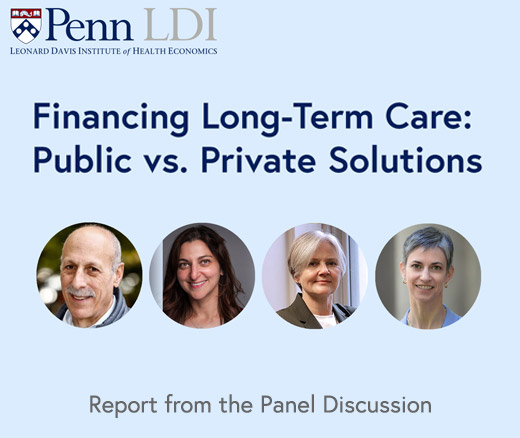
Toward a More Humane and Economically Viable Long-Term Care System
A Penn LDI Virtual Panel Looks Ahead at New Possibilities
Improving Care for Older Adults
Blog Post

About one in nine Americans age 65 and older live with Alzheimer’s dementia. As the U.S. population of older adults continues to grow, the number of Americans living with Alzheimer’s disease and related dementias is projected to grow as well, from 6.9 million in 2024 to 13.8 million by 2060.
Aging in place—or remaining at home as you age – is the preferred option for many older adults. Indeed, the practice is often promoted by clinicians and policymakers. For people with dementia, this often requires caregiving support from family or loved ones. To better understand how decisions about aging in place are made, we conducted a study, published in the Journal of the American Geriatrics Society, in which we interviewed 74 key stakeholders.
In partnership with the Penn Memory Center, we interviewed 14 people living with mild cognitive impairment or mild dementia, 36 family care partners of persons living with mild, moderate, or severe dementia, and 24 dementia clinicians, including physicians, advance practice providers, occupational therapists, and social workers. Our findings illuminate the reasons why these groups prefer aging in place and pivot to care in residential facilities.
Preferences for aging in place are driven by:
Importantly, these findings include the perspectives of people living with dementia, a group often excluded from research given their cognitive impairments. However, patient voices are essential for understanding decision making in this area. For example, preserving independence is a clear priority for this group:
I wanna keep my independence as long as I can. I wanna be able to do what I wanna do when I wanna do it… So, as long as we can be here [at home] and be independent, it’s fine.
The inclusion of dementia clinicians in our interviews also highlights places of overlap with patients’ and care partners’ perceptions. It may come as a surprise that clinicians, not just patients and family members, expressed distrust in residential care facilities. One clinician voiced these concern:
Our nursing home care is not great in this country. There’s also a lot of inequity based on your income, the quality of care that you receive, and patients and their families worry about subjecting them to poor care.
Changes to the patient’s care needs or their partner’s ability to fulfill their role could prompt a transition to a residential facility. For many, these decisions were reactive and did not feel like an active choice. Triggers included safety concerns, the patient’s increased physical dependence, or the care partner’s death, illness, or burnout:
Why did I leave [independent living]? I fell, and I laid unconscious for a short time, and I got up and told the kids, and they said I need to be somewhere where someone will take an interest…(Patient with mild cognitive impairment)
We got to a point where I just said I can’t do this anymore. I couldn’t continue giving that much of myself to caretaking for my dad and manage my family and still have time—it just wasn’t working. (Care partner)
In contrast, some families shifted proactively to care in a residential facility or adapted their own home to better care. These families tended to possess advanced knowledge of dementia and significant financial resources. The costs of these changes can be astronomical, which is often why so many families avoid these transitions until forced to do so.
In 2024, health costs from dementia are estimated at $360 billion, the majority of which is covered by Medicare and Medicaid. However, this doesn’t include the value of 18.4 billion hours of unpaid caregiving labor per year (estimated at $346.6 billion). This shifting of costs to families can be devastating, as one social worker noted:
The worst part of my job is explaining to people that Medicare is not going to cover any of the care that they need in the long term. People really don’t know this. And this happens like 10 times a week. [Families] ask, all right, how do I call Medicare to get a homecare aide, and we have to tell them that Medicare’s not going to cover that.
Future policies must take into account both the costs to insurers and the estimated costs of unpaid caregiving. Ignoring the latter places added burden on patients and their families and may keep people from working, posing consequences for the economy. Affordable and accessible home support services, adult day care, and caregiver respite may help people with dementia receive the care they prefer. At minimum, we need to better educate patients and families about what care is and is not covered by insurance.
Clinicians must also acknowledge the factors that drive preferences for aging in place and how they keep patients and families from thinking about future needs. These preferences are so strong that families see residential facilities only as a last resort. This gets in the way of making plans to improve care in the home and finding acceptable facilities down the line.
It’s widely accepted that most older adults, including those with dementia, prefer to remain in their own homes as they age. However, the notion that patients make the “choice” to age in place is flawed. We found that patients and families often feel forced to pursue one path or the other, and few can make the informed decision to seek care in a residential facility or make home adaptations. As researchers, we should not continue to report time spent at home as a positive outcome for studies or policy initiatives in dementia care, without also measuring caregiver wellbeing, patient distress, financial burdens, and more.
Despite the growth of Alzheimer’s dementia, public knowledge of how to support aging in place remains limited. To promote patient and care partner agency, we need to do more to improve the decision-making process in this area.
The study, ““What Choice Do We Have?” Reactive and Proactive Decision-Making for Aging in Place With Dementia,” was published in the Journal of the American Geriatrics Society on August 14, 2024. Authors include Catherine L. Auriemma, Maayra I. Butt, Julia McMillan, Jasmine A. Silvestri, Carolyn Chow, Melanie Bahti, Tamar Klaiman, Kristin Harkins, Jason Karlawish, and Scott D. Halpern.



A Penn LDI Virtual Panel Looks Ahead at New Possibilities

Lessons from the Past, Imperatives for the Future

Technology Helps Older Adults Stay at Home—But May Delay Necessary Transitions to Higher Levels of Care

Her Transitional Care Model Shows How Nurse-Led Care Can Keep Older Adults Out of the Hospital and Change Care Worldwide

Direct-to-Consumer Alzheimer’s Tests Risk False Positives, Privacy Breaches, and Discrimination, LDI Fellow Warns, While Lacking Strong Accuracy and Much More

New Therapies Inspire Hope, Even as Access and Treatment Risks Continue to Challenge Patients and Providers